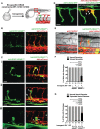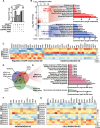Somatic Gain of KRAS Function in the Endothelium Is Sufficient to Cause Vascular Malformations That Require MEK but Not PI3K Signaling
- PMID: 32552404
- PMCID: PMC7447191
- DOI: 10.1161/CIRCRESAHA.119.316500
Somatic Gain of KRAS Function in the Endothelium Is Sufficient to Cause Vascular Malformations That Require MEK but Not PI3K Signaling
Abstract
Rationale: We previously identified somatic activating mutations in the KRAS (Kirsten rat sarcoma viral oncogene homologue) gene in the endothelium of the majority of human sporadic brain arteriovenous malformations; a disorder characterized by direct connections between arteries and veins. However, whether this genetic abnormality alone is sufficient for lesion formation, as well as how active KRAS signaling contributes to arteriovenous malformations, remains unknown.
Objective: To establish the first in vivo models of somatic KRAS gain of function in the endothelium in both mice and zebrafish to directly observe the phenotypic consequences of constitutive KRAS activity at a cellular level in vivo, and to test potential therapeutic interventions for arteriovenous malformations.
Methods and results: Using both postnatal and adult mice, as well as embryonic zebrafish, we demonstrate that endothelial-specific gain of function mutations in Kras (G12D or G12V) are sufficient to induce brain arteriovenous malformations. Active KRAS signaling leads to altered endothelial cell morphogenesis and increased cell size, ectopic sprouting, expanded vessel lumen diameter, and direct connections between arteries and veins. Furthermore, we show that these lesions are not associated with altered endothelial growth dynamics or a lack of proper arteriovenous identity but instead seem to feature exuberant angiogenic signaling. Finally, we demonstrate that KRAS-dependent arteriovenous malformations in zebrafish are refractory to inhibition of the downstream effector PI3K but instead require active MEK (mitogen-activated protein kinase kinase 1) signaling.
Conclusions: We demonstrate that active KRAS expression in the endothelium is sufficient for brain arteriovenous malformations, even in the setting of uninjured adult vasculature. Furthermore, the finding that KRAS-dependent lesions are reversible in zebrafish suggests that MEK inhibition may represent a promising therapeutic treatment for arteriovenous malformation patients. Graphical Abstract: A graphical abstract is available for this article.
Keywords: brain; cell size; endothelium, vascular; models, animal; vascular disease.
Conflict of interest statement
None.
Figures







Comment in
-
Oncogenes in Brain Arteriovenous Malformations.Circ Res. 2020 Aug 28;127(6):744-746. doi: 10.1161/CIRCRESAHA.120.317722. Epub 2020 Aug 27. Circ Res. 2020. PMID: 32853093 No abstract available.
Similar articles
-
Somatic Activating KRAS Mutations in Arteriovenous Malformations of the Brain.N Engl J Med. 2018 Jan 18;378(3):250-261. doi: 10.1056/NEJMoa1709449. Epub 2018 Jan 3. N Engl J Med. 2018. PMID: 29298116 Free PMC article.
-
Somatic mosaicism in the MAPK pathway in sporadic brain arteriovenous malformation and association with phenotype.J Neurosurg. 2021 Jul 2;136(1):148-155. doi: 10.3171/2020.11.JNS202031. Print 2022 Jan 1. J Neurosurg. 2021. PMID: 34214981 Free PMC article.
-
Selective Endothelial Hyperactivation of Oncogenic KRAS Induces Brain Arteriovenous Malformations in Mice.Ann Neurol. 2021 May;89(5):926-941. doi: 10.1002/ana.26059. Epub 2021 Mar 22. Ann Neurol. 2021. PMID: 33675084
-
Advances in the Study of KRAS in Brain Arteriovenous Malformation.Cerebrovasc Dis. 2024;53(6):767-775. doi: 10.1159/000535139. Epub 2023 Nov 10. Cerebrovasc Dis. 2024. PMID: 37952527 Review.
-
Review of treatment and therapeutic targets in brain arteriovenous malformation.J Cereb Blood Flow Metab. 2021 Dec;41(12):3141-3156. doi: 10.1177/0271678X211026771. Epub 2021 Jun 23. J Cereb Blood Flow Metab. 2021. PMID: 34162280 Free PMC article. Review.
Cited by
-
KRAS mutation-induced EndMT of brain arteriovenous malformation is mediated through the TGF-β/BMP-SMAD4 pathway.Stroke Vasc Neurol. 2023 Jun;8(3):197-206. doi: 10.1136/svn-2022-001700. Epub 2022 Nov 23. Stroke Vasc Neurol. 2023. PMID: 36418055 Free PMC article.
-
An Updated Review on the Pathogenesis of Brain Arteriovenous Malformations and Its Therapeutic Targets.J Neuroendovasc Ther. 2025;19(1):2024-0008. doi: 10.5797/jnet.ra.2024-0008. Epub 2024 May 21. J Neuroendovasc Ther. 2025. PMID: 39958460 Free PMC article. Review.
-
Cellular loci involved in the development of brain arteriovenous malformations.Front Hum Neurosci. 2022 Sep 21;16:968369. doi: 10.3389/fnhum.2022.968369. eCollection 2022. Front Hum Neurosci. 2022. PMID: 36211120 Free PMC article. Review.
-
The Role and Therapeutic Implications of Inflammation in the Pathogenesis of Brain Arteriovenous Malformations.Biomedicines. 2023 Oct 24;11(11):2876. doi: 10.3390/biomedicines11112876. Biomedicines. 2023. PMID: 38001877 Free PMC article. Review.
-
State of the Art in the Role of Endovascular Embolization in the Management of Brain Arteriovenous Malformations-A Systematic Review.J Clin Med. 2022 Dec 4;11(23):7208. doi: 10.3390/jcm11237208. J Clin Med. 2022. PMID: 36498782 Free PMC article. Review.
References
-
- Solomon RA, Connolly ES., Jr. Arteriovenous malformations of the brain. N Engl J Med 20173761859–1866doi: 10.1056/NEJMra1607407 - PubMed
-
- Yun JH, Kwon DH, Lee EJ, Lee DH, Ahn JS, Kwun BD. New nidus formation adjacent to the target site of an arteriovenous malformation treated by Gamma Knife surgery. J Neurosurg 2012117suppl120–125doi: 10.3171/2012.8.GKS12994 - PubMed
-
- Oka M, Kushamae M, Aoki T, Yamaguchi T, Kitazato K, Abekura Y, Kawamata T, Mizutani T, Miyamoto S, Takagi Y. KRAS G12D or G12V mutation in human brain arteriovenous malformations. World Neurosurg 2019126e1365–e1373doi: 10.1016/j.wneu.2019.03.105 - PubMed
-
- Priemer DS, Vortmeyer AO, Zhang S, Chang HY, Curless KL, Cheng L. Activating KRAS mutations in arteriovenous malformations of the brain: frequency and clinicopathologic correlation. Hum Pathol 20198933–39doi: 10.1016/j.humpath.2019.04.004 - PubMed
Publication types
MeSH terms
Substances
Grants and funding
LinkOut - more resources
Full Text Sources
Medical
Molecular Biology Databases
Research Materials
Miscellaneous

